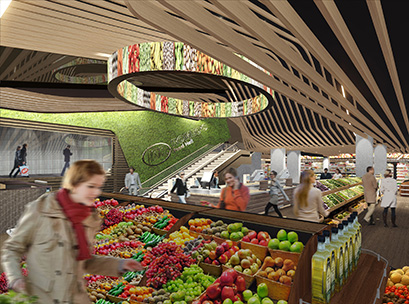 Metcash shares have nosedived following the announcement that the key South Australian customer, Drakes Supermarkets, has decided not to renew a supply contract.
Metcash shares have nosedived following the announcement that the key South Australian customer, Drakes Supermarkets, has decided not to renew a supply contract.
The announcement saw the Metcash share price tumble to $2.90 on Monday, down around 80 cents on the previous week’s year high of $3.73.
Metcash has steadily recovered from its dismal September 2015 share price of $0.96 after divesting its automotive division, cleaning house on financial ghosts and restructuring its core food and liquor division.
While increasing competition in the supermarket sector and sluggish consumer spending have prevented the grocery, liquor and hardware wholesaler from enticing shareholders to return share values above $4.00, Metcash has arguably done better in the past two years than might have been expected.
Restructuring the food and liquor business and positive performances from the hardware division that added the Home Timber and Hardware banner to the Mitre 10 business stabilised the company and secured investor support.
However, investors are now nervous about the future prospects of the company following Drakes Supermarkets’ decision to not renew its supply contract with Metcash and instead establish its own warehouse facility in Adelaide.
Drakes Supermarkets has around 50 stores throughout South Australia and Queensland generating annual sales of more than $1 billion.
The retailer has yet to indicate any plans it may have to change supply arrangements for its Queensland stores but it has rebranded stores in that state from IGA to Drakes Supermarkets.
The decision was prompted by concerns that smaller IGA stores were blurring customers’ perception of what Drakes’ larger Supa IGA stores offered in range, services and pricing. That concern was also a factor in its South Australian supply contract decision.
The grocery business, arguably more than any other retail business, is about scale.
Metcash was created through a series of acquisitions of state-based grocery and liquor wholesalers by South African retailer, Metro Cash and Carry, ahead of a listing on the Australian Stock Exchange (ASX).
The rationale behind the acquisitions of the various wholesalers was the need to achieve scale and a national entity that could maximise buying power and optimise operating costs to ensure independent retailers could continue to compete with the major chains.
Metcash initially was able to bank the synergy benefits of the acquisitions and to achieve better deals from suppliers while also adding additional customers when Franklins quit the Australian market.
A fundamental problem has always dogged Metcash, however: the challenge of matching the chains in supply and retail store support efficiencies when its customers range in size from little more than corner shops to full-scale supermarkets.
Metcash recognised the challenges it faced in maintaining sales and profit growth in supermarkets and the convenience sector and sought to extend into other retail categories such as pharmacy, automotive aftercare and hardware. But the company couldn’t convince a pharmacy wholesaler to become part of its operations and decided to abandon the automotive category when it struck financial problems in 2015.
Hardware has proved a better bet, at least in the short term, with the failure of Woolworths’ Masters Home Improvement chain. Virtually all of the earnings growth and a large slice of any gain in sales for the current financial year will come from the hardware division.
Metcash advised the ASX last week that it expects to report a 1.2 per cent decline in supermarket and convenience store total sales and a 3.6 per cent drop in supermarket wholesale revenues, excluding tobacco, for the 2018 full financial year.
For the past three years, Metcash has pursued a strategy to assist the independent IGA store network to compete in an increasingly competitive grocery market. The strategy has saved sales rather than achieved growth in the face of greater competition, especially in South Australia and Western Australia, where Aldi has now rolled out stores.
The Aldi challenge, along with the expansion of Costco and the launch of Kaufland in the Australian market is a key factor in the decision by Drakes Supermarkets to build its own warehouse and deal directly with suppliers for its 39 South Australian stores.
The decision is a $270 million hit to Metcash revenues and a loss of around around $16 million in pre-tax earnings.
The damage, however, could yet be far greater, in the first instance with the potential loss of the Drakes Supermarkets business in Queensland, but more significantly if other South Australian retailers join Drakes Supermarkets.
Drakes Supermarkets is the leading independent grocery retailer in South Australia and has been influential in the close-knit Foodland group of independents, which have traded under the Metcash IGA banner for several years.
Drakes Supermarkets has not given any indication it will entertain discussions on supply agreements with the former Foodland Group, with which the 38-store Romeo’s chain is also aligned, or South Australian stores in the FoodWorks network.
The prospect of larger supermarkets in South Australia, and potentially across the border in western New South Wales and Victoria, joining Drakes Supermarkets is a genuine threat now and in the future to Metcash.
Small food stores supplied by Metcash have enjoyed a piggyback ride courtesy of the larger independent chains supplied by Metcash, and the loss of large customers will increase operating costs and eat sharply into profits.
There will be a multiplier effect on Metcash earnings resulting from the Drakes Supermarkets exit that analysts and investors have yet to factor into their forecasts on future financial results.
Drakes’ $80 million distribution centre will be built on 17-hectare site in the Adelaide suburb of Edinburgh North. Expected to be operational by June 2019, the 104,000sqm centre will carry at least 23,000 product lines, including grocery, dairy and frozen goods. Drakes expects to achieve enhanced stock management with a $12 million investment in robotics as part of the warehouse picking system.
The retailer has a fruit and vegetable centre at Pooraka and another centre that handles meat product distribution at Beverley. The Edinburgh North site allows for further expansion, supporting the growth of Drakes Supermarkets, but also potentially allows other retailers to switch from Metcash.
It is not clear if the decision by Drakes Supermarkets will trigger a buyback by the retailer of a 26 per cent stake Metcash has in an entity called Dramet, which owns 15 stores.
Metcash took equity positions in a number of key customers to protect its income, but that strategy may now also unravel following Drakes Supermarkets’ move to direct source its grocery lines.
Metcash has indicated it is assessing the implications of the loss of one of its most important customers and is also considering possible adjustments to the carrying value of its goodwill and other assets.
Drakes Supermarkets’ distribution centre may force Metcash to abandon or, at least, modify plans it had for a new warehouse complex it was keen to develop in South Australia.
Jeff Adams, the newly installed Metcash CEO, is due to report results on June 25, with analysts and shareholders keen to learn about progress in the company’s strategic plan and the likelihood of any further supply contract losses.
The Drakes decision takes the gloss off a deal struck last month with JD.com for the release of the Metcash Fresh Pantry brand products on the Chinese retail giant’s e-commerce site.
The Fresh Pantry brand includes food, wine, skincare and healthcare products as well as household and baby goods.






